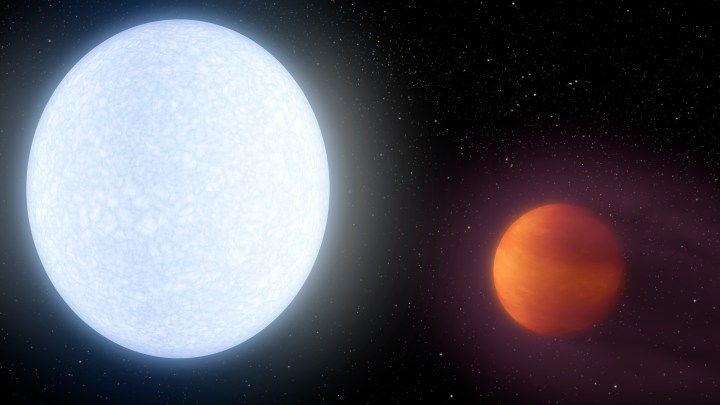
Dubbed KELT-9b, the planet’s features are strange, to say the least. It is nearly three times the size of Jupiter. It is a gas giant that is tidally locked to its host star, like the moon is to Earth. That means one of the planet’s sides is constantly pointed toward its sun, causing it to bask in temperatures over 7,800 Fahrenheit, only 2,000 degrees cooler than the surface of our sun. On top of that, the planet’s “year” — how often it orbits its star — is just about 1.5 Earth days long.
In fact, KELT-9b is so unusual, the researchers who discovered first thought their data was wrong.
“I thought it couldn’t be real,” Scott Gaudi, an astronomer at the Ohio State University, told Digital Trends. “We always joke with KELT that either we’ve discovered the most amazing planet ever — or it is a false positive. Turns out, in this case, it was real. Even after 22 years in astronomy, I’m still occasionally floored by what the universe reveals.”
KELT-9b isn’t the only giant in the neighborhood. It’s star, KELT-9, is almost twice as large and twice as hot as our sun, which makes it tough to even spot the planet. Astronomers first discovered KELT-9b when they noticed a fractional dip — about half of one percent — in the host star’s brightness.
KELT-9 contributes to most of the planet’s extremities. The star’s intense radiation has bloated KELT-9b’s atmosphere into a balloon while sizzling its surface. All this intensity comes at a cost. According to Keivan Stassun, an astronomer from Vanderbilt University who led the study with Gaudi, KELT-9b’s existence will be turbulent.
“The future for KELT-9b is likely to be quite interesting and dramatic,” he told Digital Trends. “The planet receives such an intensity of extreme ultraviolet radiation from the host star that its atmosphere is very likely being boiled away. By the time the star begins to die in a billion years, all that may be left of the planet is its rocky core, if it has one. And all of that before the planet almost certainly gets gobbled up by the star as it swells to become a red giant in its final days.”
The researchers published their findings this week in the journal Nature.
Editors' Recommendations
- Astronomers discover enormous planet in extreme, massive star system
- Astronomers use new technique to search for Planet Nine
- Amateur astronomer discovers huge asteroid that will cruise past Earth
- Is Planet Nine a miniature black hole? Scientists have a way to find out
- Amateur astronomer discovers a brand new spot on Jupiter


